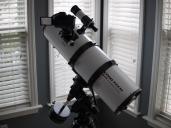
-
When comparing neighboring apertures the effect it's not very apparent but usually comparing crops 2/3EV apart you will see a difference. Having said that, I can say I'm pretty confortable up to f/11-13 even though if you compare to f/9 you can spot a marginal difference. These are 100% crops. Had to shoot these at ISO640 because that was the needed amplification for F22@2fps. Shot on tripod with constant lighting. At very wide apertures (F/5.6 and faster) there is flickering from the lighting but it doesn't make a difference for this purpose.
BTW I also tested with a chart on the center and another on the corner but the diffraction settles in equally as expected, so I'm publishing this test where I zoomed in on the chart and it's easier to see the differences.
A zip file with all images is also here: http://www.mediafire.com/?hwotq64ixux4z9k
-
Big thanks for testing and post. But. One lens - one topic. http://www.personal-view.com/talks/discussion/873/45mm-f1.8-olympus-topic#Item_50
-
@Vitaliy_Kiselev : I wondered whether I should post that in the Lenses Section, but then I though "Diffraction is a sensor characteristic" so it will be similar for all lenses that out-resolve the sensor (and at video resolutions mostly all will) so I posted here in the Camera Section.
-
@duartix Great to see the tests. :)
Though diffraction affects all lenses, the aperture where you start to lose resolution varies from lens to lens.
-
This test is extremely useful for astrophotography which I am heavily invested(literally) right now. Most scopes are F10 out of the box. Any barlows at all will push it out to F20 and beyond.
I bought an 8" 800mm F4.0 scope so I can use a 3x barlow without much issue. I have a 2x, 3x, and 5x on the way. I can also use the 2.6x and 3.9x ETC features to get around the diffraction issue at extreme amplification.
I laugh when everyone asks why there isn't a 800mm F4.0 lens for m4/3s. Attached is a picture of a reasonably priced 800mm F4.0 lens. Trust me this will not fit in your pocket.

 P1710615_resize.jpg1600 x 1200 - 447K
P1710615_resize.jpg1600 x 1200 - 447K -
@mpgxsvcd : Is it stabilised? How much was "heavily invested"? And I don't mean pounds... oh wait, perhaps I do, where in the planet are you?
-
A 600mm f/4.0 Canon L series costs over $10,000 U.S. - tack on another $500 or so for 2x extender. Not sure how the telescopes compare but that`s the most expensive I used for astrophotography so far and with the case it was ca. 30 lbs to carry around.
-
I live in North Carolina in the US. The 8" Astro tech weighs about 20 pounds. The scope itself was only $499 and it is just about perfect for most deep space objects. The real cost is a decent Goto German equatorial mount and all of the accessories that go with it. I have about $2000 invested into those.
The scope wouldn't be very useful for day time application. It is very useful for AP though.
I am working on a video tutorial on how to do Astro Photography from a heavily light polluted back yard on a budget. We finally have clear skies tonight so most of the footage will come from tonight's session.
-
LOL I have exactly the same set-up 8" F5 reflector - sadly bang in the middle of London - got some nice shots of Jupiter and moons though the other day
-
I find that the 2 minute 8 second exposure limit of the GH2 means focal ratio is everything. That is why I went with the F4.0 scope instead of an F5.0 or greater. The 800mm focal length is nice as well. It allows me to frame the full moon in 16:9 perfectly and Orion's Nebula just fills the frame.
Howdy, Stranger!
It looks like you're new here. If you want to get involved, click one of these buttons!
Categories
- Topics List23,993
- Blog5,725
- General and News1,354
- Hacks and Patches1,153
- ↳ Top Settings33
- ↳ Beginners256
- ↳ Archives402
- ↳ Hacks News and Development56
- Cameras2,368
- ↳ Panasonic995
- ↳ Canon118
- ↳ Sony156
- ↳ Nikon96
- ↳ Pentax and Samsung70
- ↳ Olympus and Fujifilm102
- ↳ Compacts and Camcorders300
- ↳ Smartphones for video97
- ↳ Pro Video Cameras191
- ↳ BlackMagic and other raw cameras116
- Skill1,960
- ↳ Business and distribution66
- ↳ Preparation, scripts and legal38
- ↳ Art149
- ↳ Import, Convert, Exporting291
- ↳ Editors191
- ↳ Effects and stunts115
- ↳ Color grading197
- ↳ Sound and Music280
- ↳ Lighting96
- ↳ Software and storage tips266
- Gear5,420
- ↳ Filters, Adapters, Matte boxes344
- ↳ Lenses1,582
- ↳ Follow focus and gears93
- ↳ Sound499
- ↳ Lighting gear314
- ↳ Camera movement230
- ↳ Gimbals and copters302
- ↳ Rigs and related stuff273
- ↳ Power solutions83
- ↳ Monitors and viewfinders340
- ↳ Tripods and fluid heads139
- ↳ Storage286
- ↳ Computers and studio gear560
- ↳ VR and 3D248
- Showcase1,859
- Marketplace2,834
- Offtopic1,320






